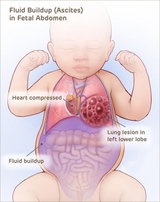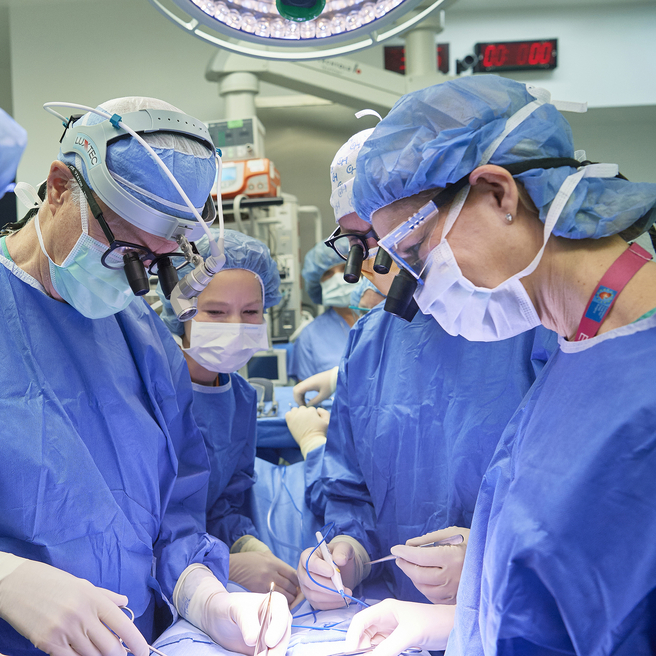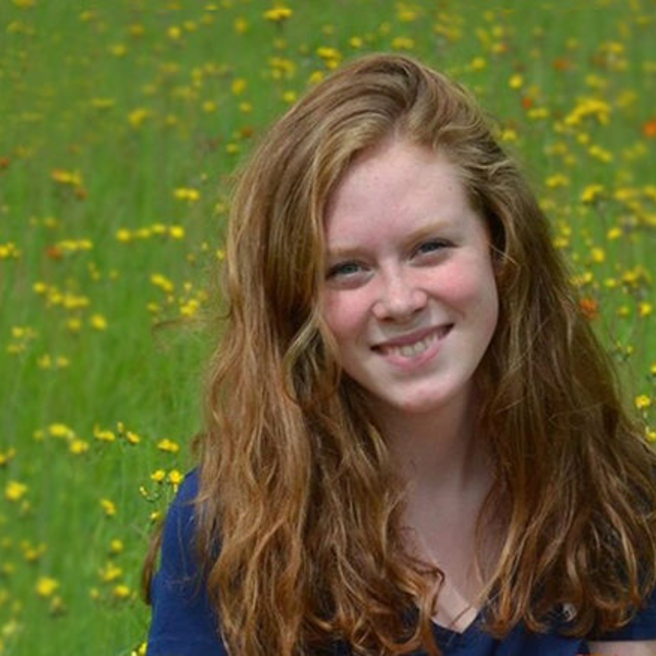What is a hybrid lesion?
A hybrid lesion is a rare birth defect in which an abnormal mass of nonfunctioning lung tissue forms during prenatal development. Hybrid lesions are characterized by an abnormal blood supply from two sources: an arterial blood vessel coming from the aorta (the largest blood vessel going to the body from the heart), as well as a vessel coming from the lungs.
A hybrid lesion is a combination of a congenital cystic adenomatoid malformation (CCAM) and a bronchopulmonary sequestration (BPS). The mass can form outside (extralobar) or inside (intralobar) the lungs. The term “hybrid lesion” was invented at CHOP in 1998.
Treatment of hybrid lesions depends on the type and size of lung lesion, as well as whether the condition is causing any serious health complications for mother or baby.
Hybrid lesions can lead to breathing problems, infection, life-threatening complications like heart failure, and in rare instances, the risk of the mass turning cancerous. Surgery is needed to remove the abnormal tissue.
Most children with hybrid lesions can be safely treated with surgery after birth. In rare cases before birth — when the lesion has grown abnormally large, is restricting lung growth or impairing blood flow, putting your baby at risk for heart failure — fetal intervention may be necessary.
Types of hybrid lesions
There are two types of hybrid lesions:
- Intralobar, in which the mass forms inside the lungs, are generally isolated birth defects. All intralobar lesions require surgical removal (resection) after birth.
- Extralobar, in which the abnormal mass forms outside — but nearby — the lungs, in the chest or the abdomen. All extralobar lesions will require surgery.
Causes of hybrid lesions
The cause of hybrid lesions, as with all lung lesions, remains unknown. It has not been linked to a genetic or chromosomal anomaly, and does not appear to run in families (is not hereditary).
Most clinicians believe the condition begins during prenatal development when an extra lung bud forms in the abnormal lung tissue when a CCAM develops. Depending on when the extra lung bud forms, the hybrid lesion may become part of one of the lungs (intralobar), or grow separately (extralobar).
Signs and symptoms of hybrid lesions
Symptoms of hybrid lesions can vary, and depend on the size of the lesion.
After birth, children with hybrid lesions may experience:
- No symptoms
- Trouble breathing
- Wheezing or shortness of breath
- Frequent lung infections like pneumonia
- Upper respiratory infections that take longer than usual to resolve
- Feeding difficulties and trouble gaining weight as infants
All suspected lung lesions, whether found before or after birth, require careful imaging. Determining the type, size and location of the lesion will guide treatment recommendations.
Evaluation and diagnosis of hybrid lesions
A hybrid lesion is one of several types of congenital lung lesions and may be confused with congenital cystic adenomatoid malformation (CCAM), or bronchopulmonary sequestration (BPS). While similar in some ways, hybrid lesions, BPS and CCAM are unique conditions that require individualized treatment. These very similar, closely linked and unusual conditions makes diagnosis challenging.
Thanks to improvements in prenatal imaging, most cases of hybrid lesions are discovered during routine ultrasounds between 18 to 20 weeks’ gestation. A solid mass will typically appear on the ultrasound as a bright spot in the fetus’s chest cavity or upper abdomen. Expert fetal imaging specialists experienced in evaluating fetal lung lesions can detect the source of the blood flow to the lung lesion as well how blood is drained from the lesion. This is an important step to confirm an accurate diagnosis and distinguish between an intralobar and extralobar hybrid lesion, BPS, CCAM, or other type of fetal lung lesions.
At Children’s Hospital of Philadelphia (CHOP), our fetal radiologists, maternal-fetal medicine specialists and fetal surgeons have established ways to distinguish between the different types of lesions before your baby is born. This accurate diagnosis helps us create an optimal plan for the care of your child after birth. (Read a paper published by our team that established these diagnostic standards.)
If you are carrying a baby suspected to have a hybrid lesion, you should be seen by a center with expertise in lung lesions for a more thorough examination. More than 3,013 patients with suspected lung lesions have been referred to our team — this experience makes us uniquely equipped to evaluate and manage your baby’s condition.
When you come to the Center for Fetal Diagnosis and Treatment, you will have a comprehensive one-day evaluation. Our fetal imaging specialists use the most advanced prenatal imaging techniques available to gather detailed information about your baby’s health and make an accurate diagnosis. In most cases, you will have a high-resolution fetal ultrasound, a fetal echocardiogram to evaluate heart structure and function, and in some cases an ultrafast fetal MRI (developed at CHOP).
These specialized tests help us determine the type, size, and location of the mass, where the blood supply is coming from, and allow us to see any impact the mass may be having on your baby’s heart.

Why choose CHOP for lung lesion care
CHOP provides comprehensive care for both mother and baby diagnosed with fetal lung lesions. From before birth to long-term follow-up, we are here for you every step of the way.
Management of pregnancy with a hybrid lesion

Depending on the gestational age of your baby and the size of the mass, you will continue to have regular ultrasounds to closely monitor the growth of the lung lesion.
Rarely, these masses can grow quite large, taking up valuable space in the chest. This can restrict normal lung growth and can lead to underdeveloped lungs which will not function adequately at birth. Large masses can also shift the heart and impair blood flow. This can lead to fetal heart failure (fetal hydrops) and cause the buildup of fluid in the fetus and placenta.
Some of these masses are associated with a large pleural effusion, or fluid collection in the chest cavity. This fluid collection can also compromise the ability of the fetal heart to function normally.
Over several visits, clinicians will determine how quickly your child’s hybrid lesion is growing.
Fetal intervention for hybrid lesions
Treatment for hybrid lesions depends on the type and size of the lung lesion, as well as whether the condition is causing any serious health complications.
Some babies with hybrid lesions cannot wait for treatment after birth because the lesion is too large, growing too rapidly, or causing life-threatening complications in utero such as fetal heart failure.
Fetal interventions we offer to treat hybrid lesions include:
Steroids to prevent future growth of the lesion
Very large solid lesions sometimes respond to steroids, which may be used to interrupt the growth of the hybrid lesion. We have found that a simple two-day course of steroids administered to the mother can stunt the growth of the lung mass and prevent the need for fetal surgery in many cases. (Read a recent study from our team about the use of steroids in managing fetal lung lesions.)
Draining fluid from the chest

A small number of hybrid lesions can develop a large pleural effusion, or accumulation of fluid in the chest, outside of the lung, which can compress the lungs and heart. This fluid can be drained prenatally and a shunt can be left in place to provide continued drainage of the fluid.
The shunting procedure itself is performed under ultrasound guidance. A large trocar (hollow needle) is guided through the mother’s abdomen and uterus, and into the fetal chest. The shunt is passed through the trocar to divert the accumulated fluid from the fetal chest to the amniotic sac. The shunt will remain until delivery. The goal of these procedures is to decrease the accumulation of fluid to ward off heart failure (fetal hydrops).
Open fetal surgery to remove hybrid lesions
We have learned that open fetal surgery is now rarely necessary due to advances in care before birth. However, if your baby is not responding to other prenatal treatments and is showing early signs of heart failure (hydrops), our experienced team is prepared to remove the hybrid lesion before birth. During a fetal resection of a hybrid lesion, highly skilled fetal surgeons open the mother’s abdomen and uterus in order to remove the mass from the baby’s lung. After surgery, the fetus is returned to the womb where the normal lung can continue to grow.
C-section to resection
Babies with large lung lesions can be safely delivered by c-section and be carried immediately to the adjacent operating room where our expert fetal surgeons will remove the mass. Our Garbose Family Special Delivery Unit (SDU) was specifically designed with adjacent fetal operating rooms for this purpose. After the mass is removed, our dedicated Neonatal Surgical Team will provide further specialized care for your baby.
EXIT procedure
Rarely, a large hybrid lesion may require a specialized delivery technique such as the ex utero intrapartum treatment (EXIT) procedure. The EXIT procedure is performed in our SDU.
In an EXIT procedure, your surgical team will partially deliver the baby so that they are still attached to the placenta and receiving oxygen through the umbilical cord. This procedure allows time for fetal surgeons to establish an airway and remove the mass while the baby is still attached and supported by the mother. After removal, your baby will be delivered and our Neonatal Surgical Team will provide further specialized care.
Delivery of babies with hybrid lesions
Mothers carrying babies with small lung lesions — without other associated anomalies — may be able to deliver at their local hospital, without the need for high-risk neonatal care. Babies with larger lesions, or those with complications or associated disorders, should be delivered in a center that offers expert care for both mother and baby in one location.
At CHOP, babies with prenatally diagnosed lung lesions who will require treatment immediately or soon after birth are delivered in the Garbose Family Special Delivery Unit, specifically designed to keep mother and baby together and avoid transport of fragile infants.
Here, your baby has immediate access to the Newborn/Infant Intensive Care Unit (N/IICU) and a dedicated Neonatal Surgical Team. Our team is experienced in performing complex, delicate procedures needed to establish an airway while delivering babies who may not be able to breathe on their own at birth, as well as any immediate surgeries that your baby might need.
Surgery for hybrid lesions after birth
All hybrid lesions should be surgically removed. It is important to remove the hybrid lesion because of the increased risk of lung infection, the risk of the CCAM component of the mass turning cancerous, as well as the potential for high blood flow through the tissue that can lead to heart failure later in life.
Removing the hybrid lesion when your child is young has multiple benefits, including promoting compensatory lung growth (ability of lungs to grow and fill the space in the chest).
First, you will come in for an appointment for your baby to be evaluated by the surgical team. A CT scan with contrast will be performed to confirm the diagnosis and determine the exact location of your child’s lung lesion. Children’s Hospital of Philadelphia radiologists have set the standard for safe, low-dose imaging practices in children. We make every effort to schedule surgery as soon as possible and at a time convenient for your family. Surgery is often scheduled for the same week.
The average length of stay at CHOP after lung lesion surgery is two to three days.
Follow-up care
Follow-up care for children with hybrid lesions will depend on the treatment the child received.
Most children treated for small lesions after birth will only need monitoring for the first year after surgery to ensure normal lung growth and lung function. The majority will require no additional long-term follow-up care.
Children treated for more severe or complex lung lesions may require ongoing monitoring through childhood. For those who experience limited lung growth resulting in pulmonary hypoplasia, CHOP’s unique Pulmonary Hypoplasia Program (PHP) offers comprehensive long-term care. The PHP team provides multidisciplinary care with a focus on improving your child’s pulmonary health, evaluating neurodevelopmental growth, meeting nutritional needs, monitoring for late onset hearing loss or any surgical issues, and more.
Long-term outlook
The vast majority of children with congenital lung lesions, including hybrid lesions, do extremely well and have normal lung function after their lesions are removed. This is thanks to rapid compensatory lung growth that occurs during childhood. Having surgery early maximizes this compensatory growth.
Children with moderate to large lesions can also do extremely well, but their outlook depends on expert treatment to avoid potential complications. These babies require highly specialized expert care from time of diagnosis to delivery and surgery to ensure the best possible long-term outcomes.

Tour our Fetal Center
The Wood Center for Fetal Diagnosis and Treatment has cared for many families and will help you through your journey, too.

What to expect
From the moment of referral through delivery and postnatal care, your family can expect a supportive experience when you come to us with a diagnosis of a birth defect.
Resources to help
Hybrid Lesions Resources
Richard D. Wood Jr. Center for Fetal Diagnosis and Treatment Resources
Learning your baby has a birth defect is a life-changing experience. We want you to know that you are not alone. To help you find answers to your questions, we've created this list of educational health resources.
Reviewed by N. Scott Adzick, MD, MMM, FACS, FAAP

